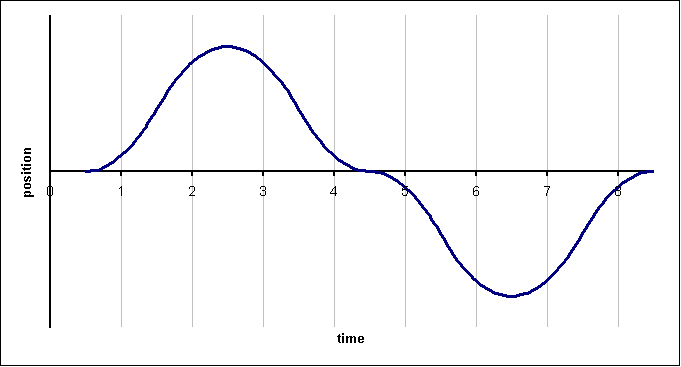Because of the similarity of the definitions of acceleration and velocity, it should be clear that acceleration can be thought of as the slope of a velocity versus time graph, just as velocity is the slope of a position versus time graph. It might not be clear, however, that we can also see the effects of acceleration in a position versus time graph.
Consider the position vs. time graph shown above. If you were to lay a ruler along the curve of the graph at the origin, the ruler would have to be horizontal to follow the curve, indicating zero slope. Thus, the velocity is zero at the origin. As you follow the curve, however, the ruler would have to be held at a steeper and steeper angle (see the lines added in the graph below). The slope grows with time, indicating that the velocity is becoming more and more positive (the speed is increasing). This positive change in velocity indicates a positive acceleration. In calculus terminology, we would say that a graph which is "concave up" or has positive curvature indicates a positive acceleration.
The Danger of Deceleration
It is important to discuss for a moment one problem with the specialized vocabulary of physics. So far, we have discussed three different aspects of motion. Each one can be discussed in terms of a vector concept (magnitude and direction) or in terms of a scalar concept (magnitude only). For instance, we discussed displacement, a vector, and distance, a scalar. For motion in one direction, distance is the magnitude of displacement. We discussed velocity, a vector, and speed, a scalar. If we are discussing instantaneous velocity, then speed is the magnitude of velocity. Our last quantity, acceleration, can also be discussed in terms of a vector acceleration or simply the magnitude, but for acceleration we have no special term for the magnitude. The vector is called "the acceleration" and the magnitude is "the magnitude of the acceleration". This can result in confusion.
This problem is exacerbated by the fact that in everyday language, we often discuss distance, speed and acceleration. The everyday definitions of distance and speed are basically equivalent to their physics definitions, since we rarely discuss direction of travel in everyday speech and these quantities are scalars in physics (no direction). Unfortunately, in physics, we usually use the term "acceleration" to refer to a vector, while in everyday speech it denotes a magnitude.
The difficulties do not end there. Everyday usage does make one concession to the vector nature of motion. When we discuss acceleration in everyday speech, we usually specify whether the object is "accelerating" (speeding up) or "decelerating" (slowing down). Both terms imply a change in velocity, and so in physics we can call either case "accelerating". The physics way of explaining the difference is:
everyday term |
physics equivalent |
|---|---|
acceleration |
acceleration and velocity point in the same direction |
deceleration |
acceleration points in the direction opposite the velocity |
To understand the physics definition, imagine a child on a playground swing. If you want to help the child swing faster, you must push them in the same direction as they are currently moving (so the acceleration of your push is in the same direction as the child's velocity). If you want to help them slow down, you must push them in the direction opposite their current motion (so that the acceleration of the push points opposite to the velocity).
The difference between acceleration and deceleration (in the everyday sense) can also be illustrated graphically:
positive acceleration |
negative acceleration |
negative acceleration |
positive acceleration |
|---|---|---|---|
|
|
|
|
Both the graphs that show "acceleration" have slopes that are steepening with time. The only difference is that one of the graphs has a steepening positive slope and the other has a steepening _negative slope. Both graphs showing "deceleration" have slopes that are approaching zero as time evolves. (Again, one has a negative slope and one has a positive slope.)
It is a very common misconception that a negative acceleration always slows down the object it acts upon. This is not true. It is important to note that a graph which has a negative slope approaching zero (slowing down) implies a positive acceleration, and a graph which has a negative slope that is steepening (speeding up) implies a negative acceleration. It may help you to remember that the concavity of the graph specifies the direction of the acceleration.






